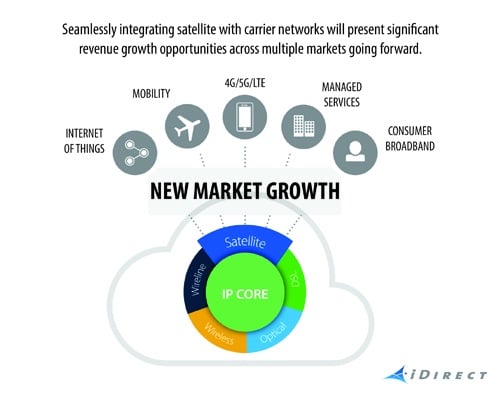In the journey towards creating the end-to-end network, telecommunications providers realize the critical role that satellite plays in meeting every customer need. They are achieving success by deploying satellite at the core of their networks.

Such success stories were front-and-center during last week’s webinar “Breaking Down the Satellite Silo” hosted by Via Satellite Editorial Director Mark Holmes. Eric Watko, Vice President, Integrated Solutions and Space Systems, iDirect, was joined by Stuart Burson, Associate Director, Satellite Solutions Group, Verizon, and Renato Goodfellow, Head of Global Satellite, BT Global Services, BT Group, in a discussion on the ways in which global carriers are integrating VSAT seamlessly into their portfolio of services.
Watko kicked of the discussion by outlining the objectives facing all parts of the value chain. For satellite, it involves overcoming barriers of interoperability, easing deployment and lowering costs. For telecom providers, it’s having all access technologies seamlessly working in unison to fulfill every customer experience.
For iDirect, the approach is holistic, from the teleport to the space segment to the terminals, all with an underlying goal of making the right investments in technology to help support this transformation. For example:
- Teleport: Becoming a virtualized gateway, maximizing processing throughput and improving management through APIs
- RF: Boosting efficiencies by increasing symbol rates, offering higher-order MODCODs and becoming DVB-S2x ready
- Terminals: Extending the lifecycle and performance of terminal hardware and enabling software-based functional upgrades
- End-to-End: Improving service delivery by tightly coupling satellite with carrier infrastructure through Layer 2 over Satellite (L2oS)
Building on this theme, Verizon and BT each presented on the ways in which they leverage iDirect technology today to deliver the value of satellite in unique ways—integrated seamlessly with their core network.
Verizon integrates VSAT into its MPLS core to deliver such services as business continuity for optical and wireless networks; disaster recovery for seamless failover during a major crisis; and primary access for remote locations in oil and gas.
For Verizon, Burson spoke about the future potential of virtualization, where satellite networking might be transitioned into a virtualized data center. This would lower operating costs and to make it easier to deploy services to customers.
For BT, satellite is an integrated part of its BT Connect solution. Goodfellow spoke of creating the most cost-effective reach possible by combining terrestrial networking with satellite access to achieve global coverage.
BT is leveraging satellite to extend coverage to remote locations, provide business continuity, and deliver cellular backhaul. iDirect’s new L2oS capability is the foundation for BT to offer end-to-end Ethernet like service.
In creating a true end-to-end network, the ability to find new ways to link satellite closer to the core network helps deliver the best performance. Both Verizon and BT are demonstrating how to do so in manner that is effective for both their business and their customers.